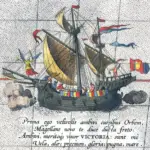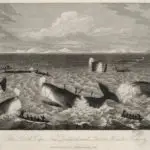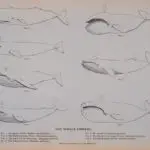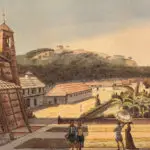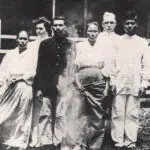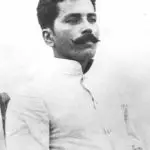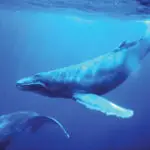Whaling Influence in the Marianas
Table of Contents
Share This
Whaling brought trade, travel opportunities and disease
Eleven CHamoru/Chamorro men, kidnapped in Guam by Alonso de Salazar’s crew of the Victoria on 10 September 1526, to work the ship’s water pumps, became the first known Pacific crew members of a European based vessel. The Victoria was the only surviving ship of a seven ship fleet dispatched by Spanish Emperor Charles V.
Although the mission of the Victoria and the other ill-fated ships of the expedition was to seize the Molucca Islands, Indonesia trade, the enslavement of these CHamoru men represents the beginning of a long indigenous association with European ships plying the Pacific initially for exploration’s sake.
Later, however, Europeans became successful in tracking and killing whales from which valuable oils were used for lighting lamps and making candles and quality lubricants for machines that produced cotton and woolen goods. Whalebone was also widely used for making women’s corset and skirt rings that had become popular by the early 18th century as well as for umbrellas and other household items.
Initial American whaling ventures had concentrated in the 1700s along the eastern coasts of North America where the “right whales” were found. They were “right” whales because they didn’t sink when killed, didn’t put up a vigorous fight, and were relatively close to shore. However this relatively easy availability of the right whale practically led to its extinction in these areas. Whaling ventures subsequently branched out into whale migration patterns of the northern summer months involving the North Pacific near Japan and the Arctic with Hawai’i providing a replenishing source during the fall.
Winter whaling tracks generally concentrated on the central Pacific and the north and south American coasts. In the spring, Hawai’i again offered ship replenishment and crew rejuvenation before whalers again headed to the North Pacific and Arctic in the summer. These whaling ships were predominantly from the New England coast area of the United States. The destruction of some whaling ships during the American Civil War and the growing prominence of uses of petroleum eventually hastened the decline of the whaling industry by the late 1870s.
The last whaling ship documented visiting Guam was in 1903.
Humpbacks, Grey and Blue Whales
This history of whaling in the Pacific involved the harvesting, in some cases almost to the point of extinction, of a number of whale species including (besides the right whale) the humpback, grey, and blue whales – all of which became more accessible by advances such as the invention of the explosive harpoon. These technologies and a greater awareness of whaling opportunities in the Antarctic were to usher in, over a long period of time, the commercial whaling industry of today.
Honolulu, Hawai’i functioned as the most prominent whaling port. Apra Harbor, Guam and Pohnpei also served as important ports for whaling ships plying the waters of Micronesia. Because of the seven mile distance between Apra Harbor and Hagåtña, whalers were likely given several days leave to accommodate this distance. Thirty to 60 whaling ships had visited the Mariana Islands by the 1820s.
Meeting the provisional needs of these whalers would naturally have had a positive economic impact in Guam although the degree of its impact is not consistently clear from the historical record although by its peak, the whaling industry provided approximately 18,000 pesos to the Spanish administration in Guam according to historian Don Farrell.
This revenue was however controlled by a few elite individuals and thus unavailable to the majority although informal transactions between crew members and local people could have resulted in some unrecorded financial benefits. Researcher Peter E. Patacsil put the expenditures of whalers at about 40,000 pesos per year during the 1840s through the whalers’ purchasing of aguardiente (a coconut toddy) and other local food products and entertainment.
Whaling ships provided CHamoru men with opportunities to venture from Guam although unsavory captains sometimes left CHamoru crew members stranded on other islands once they were no longer needed as Pablo Pérez, governor from 1848 to 1855, complained.
Some CHamoru men, frequently praised by other captains for their work ethics, migrated to Hawai’i via their whaling experiences, including José and Luís Custino (their original surname was Castro), early CHamoru converts to Protestantism who returned to Guam and made substantial contributions to the development of the Protestant church on the island. They enlisted the help of Protestant convert and Guam resident Jose Mendiola Taitano (Familian Cueto) who had also worked on a whaling ship.
As elsewhere in the Pacific, whaling ships provided Guam with beachcombers, prompting some whaling captains to seek provisions at Saipan instead where the incentive to desert was thought to be less and supplies cheaper to obtain.
Influenza, bibles came by whaling ship
As had other ships before them, whalers could also bring disease as was most markedly the case when influenza was deposited at Guam on 7 January 1849, from a whaling ship that had sailed from Hawai’i. At its height the disease was killing as many as 26 people a day in Hagåtña alone with a final death toll of more than two hundred people. The epidemic killed a disproportionate number of young women, a few elderly people but no young children.
Governor Pablo Pérez wrote that during the epidemic, “the Santisimo (Holy Sacrament) was carried through the streets at all hours of the day and night.” Because the Hagåtña cemetery was considered too small, most of the victims were buried in the yard of the Hospital de lazarinos in Adelup. The influenza scourge was recorded as having ended on 25 January, the same day that a large earthquake, at four minutes to 3 pm and lasting a minute and a half, struck the island, causing substantial damage to the Colegio de San Juan de Letrán and causing a newly constructed tower to collapse onto the San Ignacio church.
Francis M. Price, in describing his involvement in establishing the Protestant church in direct opposition to the well established Catholic Church in Guam, lamented the Catholic Church’s restrictions on access to Bibles which he conjectures arrived in Guam before 1850 through whaling ships. Price maintained that when word of CHamorus actually reading the Bible reached Catholic Church officials, three large baskets of these Bibles were publicly burned in 1856.
French explorer and scientist, Antoine-Alfred Marche also noted that whalers regularly visited Sumai village “whose inhabitants, and especially the women, trade with the whalers coming there every year to replenish their food supply.” He considered the whalers who landed at the village of Humåtak when he was there to have been “the scum of San Francisco’s population, and along with these, there were a few real sailors morally no better than the rest.”
Two Frenchmen from this whaler jumped ship and joined 10 other whalers who had deserted from other whaling ships “without means of support” because of bad treatment by the ships’ captains and bad food. Marche noted that the governor gave them “a real fuerte per day, 63 centimes” while Marche himself sponsored passage for one of the Frenchman on a mail ship bound for Manila.
For further reading
Farrell, Don A. History of the Mariana Islands to Partition. Saipan: Commonwealth of the Northern Mariana Islands Public School System, 2011.
Ibáñez del Carmen, Aniceto, Francisco Resano, and others. Chronicle of the Mariana Islands Recorded in the Agaña Parish Church, 1846-1899. Translated and annotated by Marjorie G. Driver. Mangilao: Micronesian Area Research Center, University of Guam, 1976.
MacDonald, Barrie. “Whaling.” In The Pacific Islands: An Encyclopedia. Edited by Brij V. Lal and Kate Fortune. Honolulu: University of Hawai’i Press, 2000.
Marche, Antoine-Alfred. The Mariana Islands. Translated by Sylvia E. Cheng. Mangilao: Micronesian Area Research Center, University of Guam, 1982.
Patacsil, Peter E. Coinage in Guam during the Spanish Era. Chapel Hill: Professional Press, 1998.
Polack, Joel Samuel. The North Cape, New Zealand, and Sperm Whale Fishery, 1838. Engraving, 95 x 155 cm. Alexander Turnbull Library, Wellington, New Zealand.
Price, Francis M. “Lights and Shadows in Guam.” In The Pacific Islanders, from Savages to Saints: Chapters from the Life Stories of Famous Missionaries and Native Converts. Edited by Delavan L. Pierson. New York: Funk & Wagnall Company, 1906.

